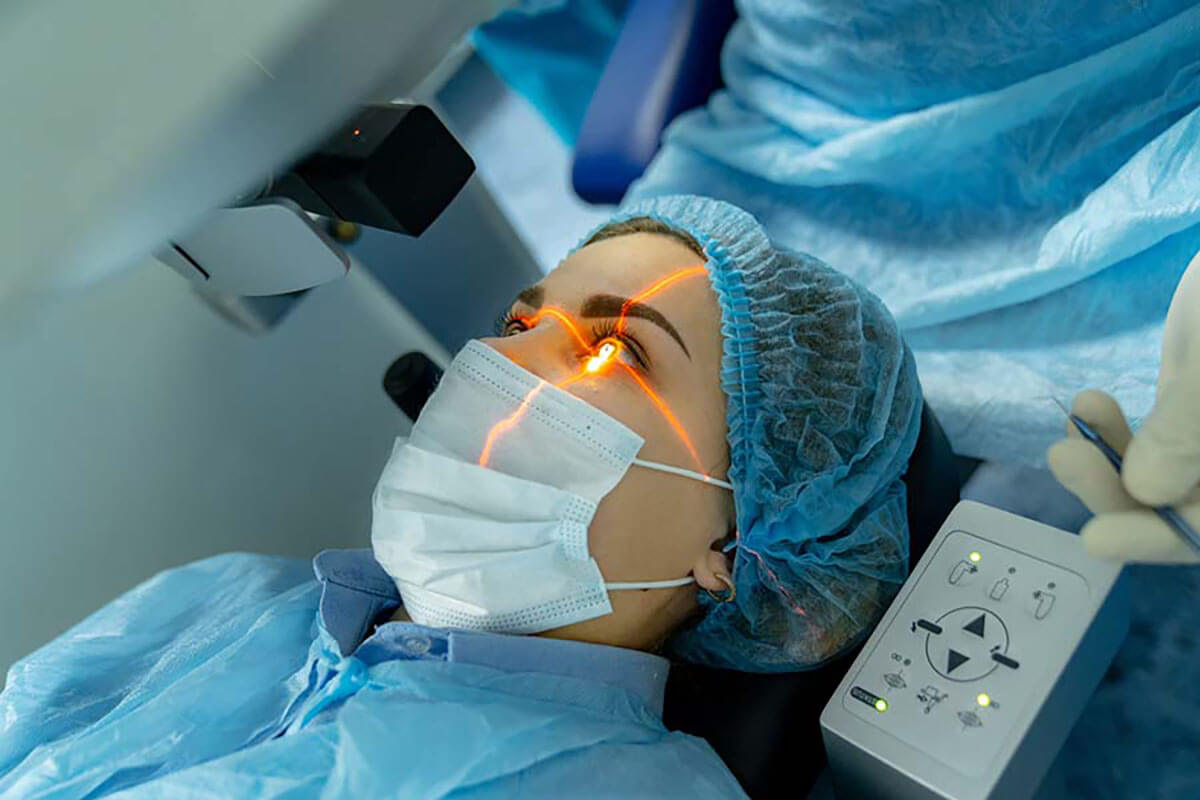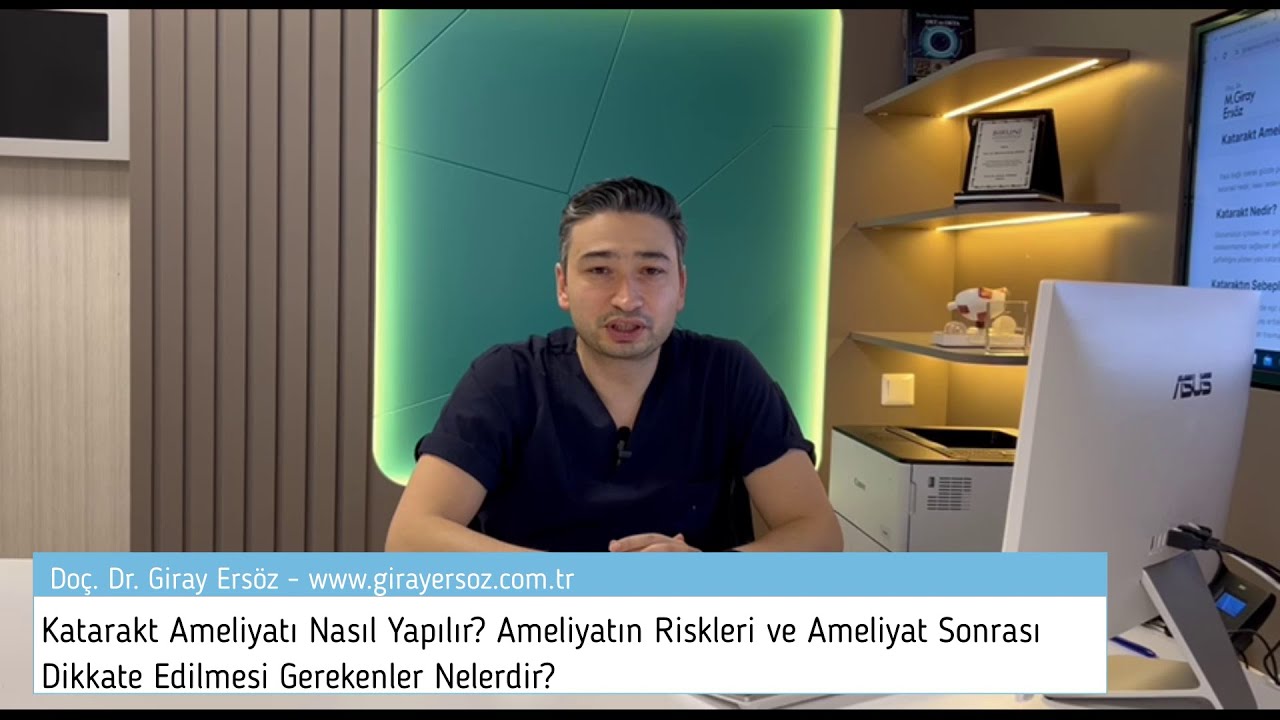Many eye diseases can occur depending on age. The most common of these is cataract disease. In this article, I will talk about what cataract is, how it is treated, how cataract surgery is performed, and the most frequently asked questions about cataracts.
What is Cataract?
Our ability to see clearly relies on the transparent lens within our eyes, facilitating focus at different distances. Cataracts occur when this lens loses transparency, impacting its functionality. Delve into the causes and consequences of this common eye condition.

Understanding the Causes of Cataracts
Cataracts, prevalent in both genders, predominantly stem from aging, with individuals over 50 at higher risk. Factors like UV exposure, diabetes, cortisone use, and eye trauma may expedite cataract formation. While rare, congenital cataracts are also observed. Explore the diverse causes influencing cataract development.
Decoding Cataract Symptoms From Blurred Vision to Light Scattering
Witness the gradual onset of cataract symptoms, starting with near vision improvement and distant vision decline. Experience light scattering and blurred vision as cataracts progress. Untreated cataracts can eventually lead to complete vision obscuration.
Delve deeper into cataract stages and treatment methods in my article, “What is Cataract? What are the Cataract Stages and Treatment Methods?” for a comprehensive understanding.
Cataract Treatment
The definitive approach to cataract disease involves surgical removal of the impaired natural lens, followed by the placement of an artificial lens for restored clarity.
Non-Surgical Options for Cataracts
Addressing a common query, this article clarifies that, regrettably, there are no non-surgical remedies for cataracts. Explore the facts and dispel misconceptions about cataract treatments.
Cataract Surgery: Understanding Optimal Timing and Considerations
Cataract surgery is typically not an immediate necessity when cataracts first develop and minimally impact visual acuity. Surgical intervention becomes a consideration if the vision drops below 70%, causing discomfort to the patient. It becomes imperative to perform cataract surgery when the vision level falls below 50%. In some instances, cataracts may not significantly reduce vision but can lead to imbalances between the eyes and severe light scattering. In such cases, early surgery enhances the patient’s quality of life. While cataract surgery is not an emergency, delays are discouraged, especially when the cataract hardens.
Pre-Cataract Surgery Evaluation
Before cataract surgery, a thorough examination is essential. The process begins with a visual acuity and anterior segment examination. Subsequently, assessments such as corneal cell count and lens measurement are conducted. Following these steps, eye drops are administered, causing pupil dilation for a comprehensive examination of the fundus, specifically the retina.
Selecting the Optimal Lens for Cataract Surgery
In the course of cataract surgery, selecting the appropriate intraocular lens (IOL) is a crucial decision. Without a properly fitted lens, patients may necessitate glasses of approximately +10 to +11 diopters post-surgery. There exist four primary types of lenses suitable for implantation in the eye. The determination of the most suitable lens is reached through an extensive eye examination and a personalized discussion between the doctor and the patient. This collaborative approach ensures that the chosen lens aligns seamlessly with the individual’s visual needs and preferences.
Types of Lenses Utilized in Cataract Surgery: Tailoring Vision for Diverse Needs
- Monofocal Lenses: Addressing distance vision, these lenses necessitate glasses for intermediate (computer distance) and near vision. While versatile for all eyes, they require additional support for various distances.
- Monofocal-Plus Lenses: Offering single-focus capability, these lenses uniquely enable clear vision for both distance and intermediate ranges without glasses. Minimal prescription glasses may be required solely for near vision.
- Trifocal Lenses (Smart Lenses): Renowned for their versatility, trifocal lenses incorporate distinct rings, facilitating clear vision at near, intermediate, and distance without the need for glasses. However, these lenses are not universally suitable, with contraindications for conditions such as keratoconus, retinal and macular degeneration.
- EDOF Lenses (Extended Depth of Focus): Distinguished by a dome-like structure, EDOF lenses lack rings but fall within the smart lens category. They provide clear vision for distance, intermediate, and near, with a slight compromise in near vision compared to trifocal lenses. Notably, EDOF lenses are applicable to a broader range of patients, including those unsuitable for trifocal lenses.
For all lens options, patients with astigmatism should opt for the corresponding “toric” lens for astigmatism correction. This comprehensive array of lenses allows for personalized selection based on individual visual requirements and conditions.
Cataract Surgery: A Brief and Painless Procedure
Cataract surgery, a swift procedure lasting approximately 15-20 minutes, is typically conducted under local anesthesia. In specific cases, such as with children or individuals prone to panic attacks, general anesthesia may be opted for. Following the surgery, which involves the removal of the clouded lens and the insertion of an intraocular lens, patients can expect to rest for about half an hour before being discharged. In cases where general anesthesia is administered, a four-hour observation period precedes discharge.
On the day of the surgery, the operated eye remains closed for 4-6 hours, after which it is briefly opened to administer prescribed eye drops, followed by closure again. The day after the surgery, during the follow-up appointment, the eye is fully opened. A month-long regimen of prescribed eye drops is continued post-surgery.
While some patients may experience mild stinging and burning sensations after cataract surgery, significant pain is not anticipated. This outpatient procedure ensures a swift recovery, allowing individuals to regain clear vision and resume normal activities shortly after the intervention.

Types of Cataract Surgery: Embracing Technological Advances
As technology continues to advance, cataract surgery has evolved, offering various methods to cater to individual patient needs. While the phacoemulsification (phaco) method is the prevailing choice, older techniques may still be employed in select cases. The primary goal across these methods is to minimize complications during surgery, ensuring optimal vision improvement post-procedure with the insertion of a new lens.
Extra Capsular Cataract Surgery
This method, once common two decades ago, is now rare. It involves larger incisions compared to modern techniques, with the entire cataract removed intact. This approach is reserved for cases with extremely hard cataracts and weakened lens ligaments.
Phacoemulsification Cataract Surgery
Phacoemulsification is the contemporary standard for cataract surgery. This technique utilizes small incisions, creating a circular opening in the anterior capsule of the cataractous lens. The cataract is then fragmented and removed using ultrasonic energy. Subsequently, a lens suitable for the eye is implanted into the lens capsule.
Laser Cataract Surgery
While not all aspects of cataract surgery can be performed using lasers, femtosecond laser is capable of making incisions and creating the necessary window in the anterior capsule. However, the subsequent phases of the surgery still employ the phacoemulsification technique. Laser cataract surgery, though precise, is less favored due to extended duration and higher costs.
The selection of a specific method is tailored to individual patient conditions, emphasizing safety during surgery and maximizing visual outcomes with the implanted lens.
Understanding the Risks Associated with Cataract Surgery
As with any surgical procedure, cataract surgery entails inherent risks. Among the primary concerns are challenges related to the placement of a lens, particularly when lens attachments are weak, and the potential for post-surgery eye infection. Skilled and experienced surgeons can mitigate the risk of lens placement issues. In instances where lens insertion is not achievable during the initial surgery, a secondary surgery may involve the placement of a stitched lens.
To safeguard against post-surgery infections, preventative measures are diligently implemented. Antibiotics are administered directly into the eye at the conclusion of the surgery, and patients are prescribed antibiotic eye drops for use in the post-operative period. These precautionary measures play a crucial role in minimizing the risk of complications, ensuring a safer and more successful recovery for patients undergoing cataract surgery.
Post-Surgery Recovery after Cataract Surgery
Following cataract surgery, the majority of patients experience noticeable improvement in vision as early as the day after the procedure, with visual acuity reaching its peak within 1-2 days. However, in cases involving particularly dense cataracts, some individuals may encounter temporary corneal edema in the days following surgery, leading to blurred vision during this specific period. Clarity is subsequently restored as the corneal edema gradually diminishes. This swift recovery timeline underscores the effectiveness of cataract surgery in swiftly enhancing and restoring vision for most patients.

Post-Cataract Surgery Conditions and Recommendations
After undergoing cataract surgery, patients may experience various conditions affecting vision and eye comfort. While some are common and resolve naturally, others may necessitate prompt attention from the treating ophthalmologist. It is essential for patients to be aware of these potential conditions and adhere to recommended post-surgery care guidelines.
Blurred Vision
Blurred vision in the initial days after cataract surgery could result from corneal edema, a condition often detected during the first post-operative check-up. Timely resolution of corneal edema typically leads to improved vision. Persistent or worsening blurred vision, especially accompanied by severe eye pain, requires immediate consultation with an ophthalmologist.
Nearsightedness
Patients receiving monofocal or monofocal-plus lenses during cataract surgery may experience difficulty seeing up close without glasses, which is a normal outcome. This condition can be addressed with the use of prescribed reading glasses.
Eye Glare & Light Reflection
Light scattering, particularly with trifocal (smart) lenses, may occur during cataract surgery but tends to diminish over time. Any unusual complaints such as flashes of light warrant prompt retinal examination.
Bloodshot Eye
Slight bloodshot eyes in the initial days after surgery may result from irregular medication use or dry eyes. Consistent use of prescribed medications and consultation with an ophthalmologist can address this issue.
Tears
Patients with mild dry eyes might experience tearing post-surgery.
Increased Eye Pressure
Although rare, increased eye pressure in the early days after surgery is typically manageable with prescribed eye drops.
Stinging in Eyes & Burning in Eyes & Dryness in Eyes
Normal sensations immediately after cataract surgery include stinging and burning, which usually last for 1-2 days. Patients with dry eyes may experience these sensations for up to six months and are advised to use suitable artificial tears.
Eye Burr
While minor burrs are normal, any severe or discolored burrs warrant immediate consultation with an ophthalmologist.
Floaters (Fly Fly)
Flashes or floaters could indicate degeneration in the vitreous gel, and patients experiencing these should undergo a retinal examination.
Inability to Look at the Light
Adjusting to increased light sensitivity after cataract surgery is common and typically improves over time. However, delayed onset or persistent light sensitivity should prompt a visit to an ophthalmologist.
Post-Surgery Care Guidelines for Cataract Surgery Patients
After cataract surgery, adherence to specific care recommendations is crucial for a smooth recovery and optimal outcomes. Here’s a detailed guide:
Medication Compliance: Use the prescribed eye drops diligently and as per the schedule outlined by your doctor.
Posture and Rest: Optimal recovery begins with lying on your back as much as possible on the first day after surgery. This helps reduce strain and promotes healing.
Avoid Excessive Forward Leaning: For the initial 3-4 days post-surgery, refrain from leaning forward excessively. This precautionary measure helps safeguard the surgical site and supports the healing process.
Showering After 2 Days: You may resume showering 2 days after the surgery. Ensure gentle care around the eye area to prevent any accidental rubbing or irritation.
Activity Restrictions for Two Weeks: For the first two weeks, it is advisable to avoid activities that involve exposure to water such as swimming, sea activities, and Turkish baths. Similarly, sauna visits should be postponed during this period.
Eye Rubbing Caution: Resist the urge to rub your eyes for the first month post-surgery. Rubbing can interfere with the healing process and may pose risks to the treated eye.
These post-surgery guidelines are designed to promote a successful recovery, minimize potential complications, and optimize the long-term results of your cataract surgery. If you have any concerns or experience unexpected symptoms, promptly consult with your ophthalmologist for personalized guidance and support.
Frequently Asked Questions
Is There a Non-Surgical Cataract Treatment?
Cataracts cannot be treated without surgery. Currently, surgical intervention is the primary and effective method for addressing cataracts.
Is Cataract Surgery the Definitive Solution?
Yes, successful cataract surgery is considered the definitive solution to cataracts. Once surgically treated, cataracts do not recur.
What Happens If I Don’t Have Surgery?
Delaying cataract surgery may result in weakened lens attachments, making it challenging for the phacoemulsification device to break down the cataract. Prolonged delays may lead to longer surgery and recovery times, with an increased risk of complications. In advanced cases (stage 4 cataract), where vision drops below 1%, patients are considered legally blind. Successful surgery at this stage can restore vision to 100%. However, in intumescent cataracts, delayed surgery may lead to gradually increasing eye pressure, potentially causing permanent optic nerve damage and blindness.
Can People with Eye Pressure Have Cataract Surgery?
Individuals with eye pressure issues, such as glaucoma, can undergo cataract surgery. In some cases, cataract surgery may even lead to a reduction in eye pressure, alleviating glaucoma-related concerns. Special precautions may be necessary for glaucoma patients during cataract surgery.









